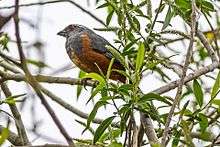Rufous-bellied mountain tanager
The rufous-bellied mountain tanager or rufous-bellied saltator (Pseudosaltator rufiventris) is a species of songbird found in a few areas in the eastern Andes of southern Bolivia and extreme northern Argentina. It occurs mostly at altitudes from 3000 m to 4000 m.[2] Its habitat is open land, including cultivated land, that has patches of scrub, alder trees, or Polylepis trees. It is threatened by habitat loss.[1]
| Rufous-bellied mountain tanager | |
|---|---|
 | |
| Scientific classification | |
| Kingdom: | Animalia |
| Phylum: | Chordata |
| Class: | Aves |
| Order: | Passeriformes |
| Family: | Thraupidae |
| Genus: | Pseudosaltator K.J. Burns, Unitt & N.A. Mason, 2016 |
| Species: | P. rufiventris |
| Binomial name | |
| Pseudosaltator rufiventris d'Orbigny & Lafresnaye, 1837 | |
It was long placed in the genus Saltator, which is now often classified with the tanagers. However, a 2007 DNA study found that the rufous-bellied saltator was closer to the chestnut-bellied mountain tanager and the buff-breasted mountain tanager than to the true saltators.[3] Because of this result and similarities in habitat and plumage, in 2010 the American Ornithologists' Union's South American Classification Committee proposed moving this species to the tanager family following those two mountain tanagers. The proposal was accepted and in 2016 second proposal, to assign a new genus and English name, was also accepted. The Clements taxonomy included these changes. To these authorities the bird is now known as rufous-vented mountain tanager, Pseudosaltator rufiventris.[4][5][6][7]
Description
The plumage is mostly blue-gray with orange underparts from the lower breast to the undertail coverts. There is a long white stripe over the eye. The bill is gray except that the base of the lower mandible is flesh-colored.[2]
References
- BirdLife International (2012). "Pseudosaltator rufiventris". IUCN Red List of Threatened Species. 2012. Retrieved 16 July 2012.CS1 maint: ref=harv (link)
- Ridgely, Robert S. (1989). The Birds of South America, Volume 1: The Oscine Passerines. University of Texas Press. p. 389. ISBN 978-0-292-70756-6. Retrieved 2012-10-12.
- Klicka, John; Burns, Kevin; Spellman, Garth M. (2007), "Defining a monophyletic Cardinalini: A molecular perspective" (PDF), Molecular Phylogenetics and Evolution, 45 (3): 1014–1032, CiteSeerX 10.1.1.550.1550, doi:10.1016/j.ympev.2007.07.006, PMID 17920298, archived from the original (PDF) on 2010-07-11, retrieved 2010-12-25
- Remsen, Van (March 2010), Transfer Saltator rufiventris from the Cardinalidae to the Thraupidae: Proposal to South American Classification Committee, retrieved 2010-12-25
- Remsen, Van (June 2016), Recognize Pseudosaltator as the genus for Saltator rufiventris (A) and change the English name of the species (B): Proposal to South American Classification Committee, retrieved 2016-11-19
- Remsen, J. V., Jr., J. I. Areta, C. D. Cadena, S. Claramunt, A. Jaramillo, J. F. Pacheco, J. Pérez-Emán, M. B. Robbins, F. G. Stiles, D. F. Stotz, and K. J. Zimmer. Version 17 November 2016. A classification of the bird species of South America. American Ornithologists' Union. http://www.museum.lsu.edu/~Remsen/SACCBaseline.htm retrieved 19 November 2016
- Clements, J. F., T. S. Schulenberg, M. J. Iliff, D. Roberson, T. A. Fredericks, B. L. Sullivan, and C. L. Wood. 2016. The eBird/Clements checklist of birds of the world: v2016. Downloaded from http://www.birds.cornell.edu/clementschecklist/download/ retrieved 11 August 2016
